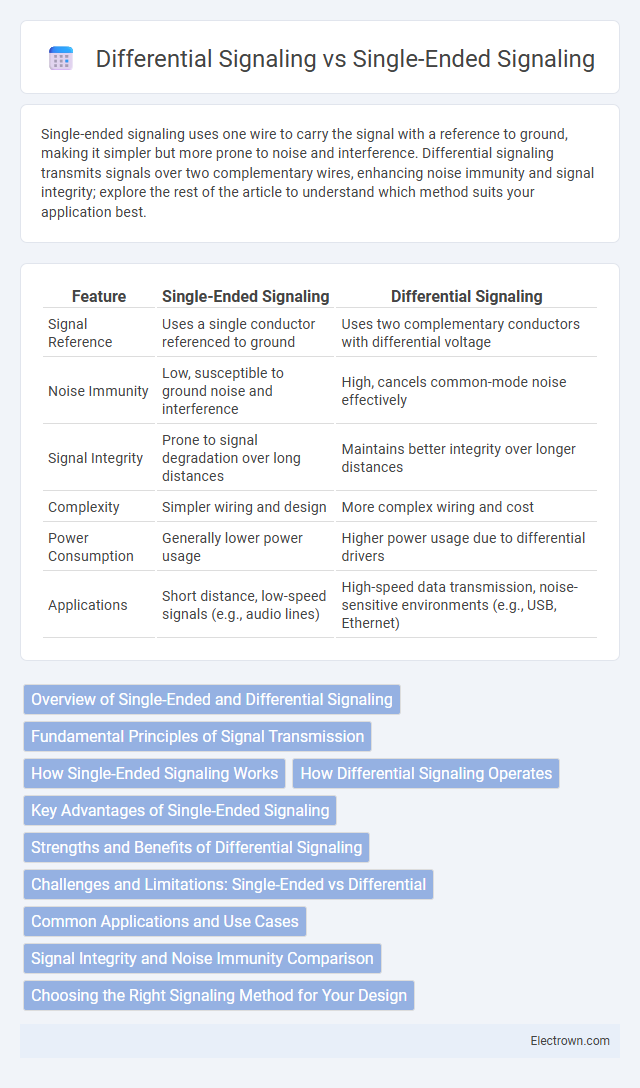Single-ended signaling uses one wire to carry the signal with a reference to ground, making it simpler but more prone to noise and interference. Differential signaling transmits signals over two complementary wires, enhancing noise immunity and signal integrity; explore the rest of the article to understand which method suits your application best.
Table of Comparison
| Feature | Single-Ended Signaling | Differential Signaling |
|---|---|---|
| Signal Reference | Uses a single conductor referenced to ground | Uses two complementary conductors with differential voltage |
| Noise Immunity | Low, susceptible to ground noise and interference | High, cancels common-mode noise effectively |
| Signal Integrity | Prone to signal degradation over long distances | Maintains better integrity over longer distances |
| Complexity | Simpler wiring and design | More complex wiring and cost |
| Power Consumption | Generally lower power usage | Higher power usage due to differential drivers |
| Applications | Short distance, low-speed signals (e.g., audio lines) | High-speed data transmission, noise-sensitive environments (e.g., USB, Ethernet) |
Overview of Single-Ended and Differential Signaling
Single-ended signaling transmits data using one signal wire referenced to a common ground, making it simpler but more susceptible to noise and electromagnetic interference (EMI). Differential signaling uses two complementary signals transmitted over a pair of wires, enhancing noise immunity by allowing the receiver to detect voltage differences, which improves signal integrity in noisy environments. Your choice between single-ended and differential signaling impacts data reliability and system performance, especially in high-speed or sensitive electronic applications.
Fundamental Principles of Signal Transmission
Single-ended signaling transmits data using one voltage reference against a common ground, making it susceptible to noise and electromagnetic interference. Differential signaling uses two complementary voltage lines, where the receiver measures the voltage difference, enhancing noise immunity and signal integrity. Understanding these fundamental principles helps optimize Your system's performance, especially in environments with significant electrical noise.
How Single-Ended Signaling Works
Single-ended signaling transmits data by sending a voltage on one wire relative to a common ground reference, where signal integrity depends on the ground return path. The voltage level on the signal wire represents the binary data, typically switching between a defined high and low voltage in relation to the ground. This method is simpler and cost-effective but more susceptible to noise and electromagnetic interference compared to differential signaling.
How Differential Signaling Operates
Differential signaling operates by transmitting two complementary signals on paired conductors, where one wire carries the positive voltage and the other carries the negative voltage. The receiver measures the voltage difference between the two signals, effectively canceling out common-mode noise and interference. This method enhances signal integrity, especially in high-speed or long-distance communication, by reducing electromagnetic interference and improving noise immunity.
Key Advantages of Single-Ended Signaling
Single-ended signaling offers simplicity and cost-effectiveness, utilizing a single wire and ground reference for data transmission, which reduces wiring complexity and material expenses. It is widely compatible with various devices and circuits, making it suitable for short-distance communication where noise interference is minimal. Your system benefits from easier implementation and lower power consumption compared to differential signaling, especially in consumer electronics and basic sensor applications.
Strengths and Benefits of Differential Signaling
Differential signaling offers superior noise immunity by transmitting signals over two complementary lines, which cancels out electromagnetic interference and enhances signal integrity in noisy environments. This method provides higher data rates and reduces electromagnetic emissions, making it ideal for high-speed communication and sensitive electronic applications. Your system benefits from increased reliability and performance, especially in long-distance or electrically noisy conditions.
Challenges and Limitations: Single-Ended vs Differential
Single-ended signaling faces challenges such as increased susceptibility to electromagnetic interference (EMI) and ground noise, resulting in signal degradation over long distances. Differential signaling, while more complex and costly due to the need for paired conductors, offers superior noise immunity and reduced crosstalk, making it ideal for high-speed and sensitive data transmission. However, differential signaling requires careful impedance matching and more intricate PCB layout to maintain signal integrity.
Common Applications and Use Cases
Single-ended signaling is commonly used in low-cost, short-distance applications such as audio interfaces, USB, and consumer electronics due to its simplicity and reduced wiring requirements. Differential signaling is preferred in high-speed data communication systems including Ethernet, HDMI, and PCIe, where noise immunity and signal integrity over longer distances are critical. Industrial automation, medical equipment, and automotive networks also utilize differential signaling to ensure reliable data transmission in electrically noisy environments.
Signal Integrity and Noise Immunity Comparison
Differential signaling offers superior signal integrity and noise immunity compared to single-ended signaling by transmitting two complementary signals, which cancels out common-mode noise and reduces electromagnetic interference (EMI). Single-ended signaling is more susceptible to noise and signal degradation over longer distances or in electrically noisy environments due to its reliance on a single voltage reference against ground. Your choice between these methods impacts reliability in data transmission, especially in high-speed communication and industrial applications.
Choosing the Right Signaling Method for Your Design
Single-ended signaling uses a single wire referenced to ground, offering simplicity and lower cost but is more susceptible to noise and interference. Differential signaling transmits two complementary signals over paired wires, providing superior noise immunity and higher signal integrity, making it ideal for high-speed or long-distance applications. Selecting the right method depends on factors such as signal quality requirements, environmental noise levels, cost constraints, and the desired data transmission speed.
Single-ended vs differential signaling Infographic

 electrown.com
electrown.com